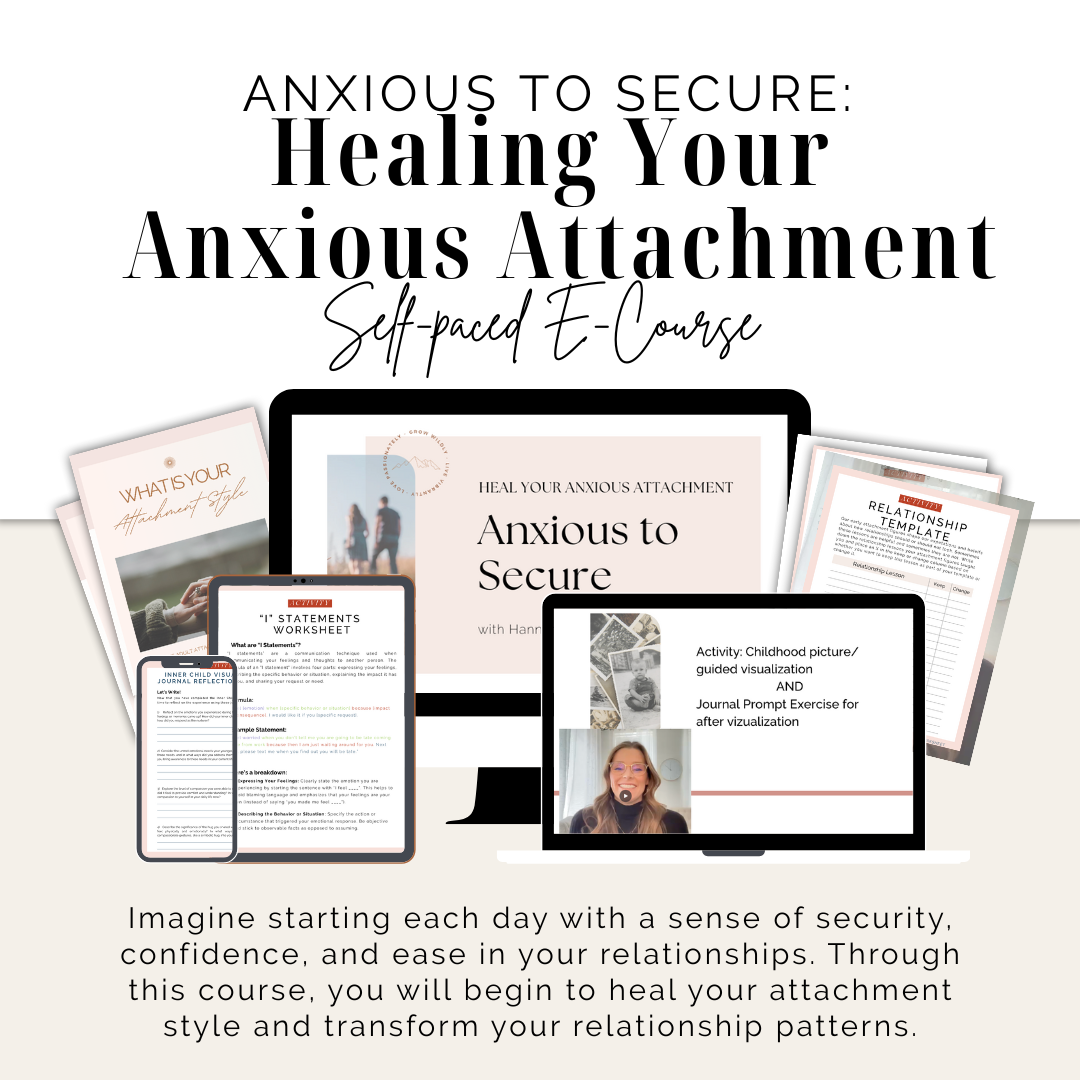Colorado
Attachment Therapy
Longing for Secure, Loving Relationships? It’s Possible.
Do you ever feel like you’re always the one who cares more? Like you're chasing closeness, but never really getting it?
Maybe you're stuck in another on-again, off-again relationship that leaves you feeling anxious, confused, or not enough. Or maybe you’re newly single (again) and wondering, “Why does this keep happening to me? Why can’t I find someone who actually shows up?”
You might feel like you give your all in relationships, only to end up hurt, ghosted, or second-guessing your worth. Maybe you’re scared to trust again—or wondering if you're just "too much" or "not enough" for the kind of love you want.
If any of that hits home, you're not alone. These patterns often trace back to attachment wounds—early experiences that shaped how safe, secure, and lovable we feel in relationships.
Attachment therapy can help you make sense of what’s really going on beneath the surface. You’ll learn why you react the way you do, how to stop repeating the same painful patterns, and how to start building relationships that actually feel safe, mutual, and fulfilling.
You can unlearn the belief that love has to feel hard, uncertain, or one-sided. Let’s work together to help you feel more secure, confident, and clear in love.
Click the button below to schedule your appointment, and let’s get started!
Check out my self-paced digital course!
Anxious to Secure—Healing Your Anxious Attachment
9-Modules with multiple video lessons
Tons of activities, exercises, guided visualizations to help increase your understanding of your anxious attachment and move you towards a more secure attachment style
Resources to continue your healing journey
Self-paced learning that you can do in your own home
Taught by me, a licensed therapist and coach!
What are “Attachment Styles?”
-
Attachment theory helps explain why relationships feel the way they do—and why you might keep ending up in patterns that feel confusing, one-sided, or painful.
Your attachment style is shaped by your early relationships with your caregivers—how emotionally available, consistent, or safe they were (or weren’t). If your caregivers were mostly responsive and attuned to your needs, you likely developed a secure attachment. But if they were unpredictable, emotionally distant, overly critical, or inconsistent, you may have developed an insecure attachment style—like anxious, avoidant, or disorganized.
These early patterns often show up in adult relationships: struggling to trust, fear of abandonment, difficulty being vulnerable, needing constant reassurance, pulling away when things get too close, or feeling like you're too much or not enough.
The good news? Your attachment style is not a life sentence. With intention, support, and the right kinds of healing experiences, your brain can rewire. You can shift toward secure attachment, feel more confident in relationships, and stop replaying the same painful dynamics.
-
If you’ve ever felt way too anxious in relationships—obsessing over texts, second-guessing everything you said, or feeling like you care “too much”—you might have an anxious attachment style.
Anxious attachment is often rooted in early relationships where love, attention, or comfort felt inconsistent. Maybe your caregiver was emotionally available sometimes, but other times they were checked out, distracted, or unpredictable. This kind of inconsistency wires your brain to stay on high alert for disconnection—because at some point, you learned that closeness could disappear without warning.
As an adult, this can show up as:
Constant worry that your partner is pulling away
Feeling like you're too much or not enough
Overanalyzing every interaction
Needing constant reassurance
Struggling to self-soothe when you're feeling triggered
When connection feels threatened (even just a delayed response or a weird tone), it can set off a spiral of anxiety and a strong urge to do something to get closeness back—texting repeatedly, over-apologizing, people-pleasing, or shutting down emotionally until the connection feels safe again.
None of this means you’re “too needy” or broken. It means your nervous system adapted to inconsistent care. The beautiful news? These patterns can change. With support, tools, and safe relational experiences, you can learn how to feel secure, grounded, and calm in relationships—without losing yourself in the process.
-
f closeness in relationships tends to feel a little too close… if you crave connection but also need a lot of space… if you’ve been told you “shut down,” “pull away,” or “seem cold”—you might lean toward an avoidant attachment style.
People with avoidant attachment do want love and connection—but getting close can feel overwhelming, even threatening. You might feel smothered or irritated when someone wants emotional intimacy, or like your partner’s needs are too much. Conflict or vulnerability might make you want to shut down, get some distance, or just not deal with it at all.
This attachment style often develops when, as a kid, you were taught—directly or indirectly—that emotions weren’t welcome. Maybe caregivers got annoyed when you were upset, told you to “toughen up,” or simply ignored your needs. Over time, you learned: relying on others doesn’t work. So you relied on yourself.
As an adult, this can look like:
Wanting connection but also needing a lot of space
Feeling uncomfortable with vulnerability
Avoiding emotional conversations
Getting overwhelmed when someone depends on you too much
Shutting down or distancing during conflict
Avoidant attachment isn’t about being cold or unfeeling—it’s about self-protection. It’s a strategy that helped you cope when you didn’t feel emotionally safe growing up.
The good news? Avoidant patterns can shift. With the right support and tools, you can learn to stay present in connection, feel safe being vulnerable, and build relationships where closeness doesn’t feel like a threat to your independence—it feels like home.
-
If you crave closeness but also push it away, if relationships feel confusing, chaotic, or unsafe—disorganized attachment might be at play.
With disorganized attachment, connection feels like a tug-of-war: Come close… but don’t get too close. You might desperately want intimacy but also feel afraid of it. You might find yourself shutting down, lashing out, panicking, or going numb—all in the same relationship.
This attachment style often forms in childhood when the very people who were supposed to be your safe place were also a source of fear or inconsistency. Maybe a caregiver was frightening, abusive, unpredictable, or emotionally unavailable in ways that left you unsure whether love would feel warm… or dangerous.
As an adult, this can look like:
Feeling torn between pulling someone in and pushing them away
Struggling to trust others (or yourself)
Cycling between clinginess and withdrawal
Having big emotional reactions that don’t always make sense to you
Feeling confused about what a “healthy” relationship even looks like
Disorganized attachment is often a response to early relational trauma—and it makes sense that your nervous system adapted in order to protect you.
The hope? This pattern can heal. You can learn to feel safe in relationships, understand your reactions, and build secure, grounded connections that don’t feel so unpredictable.
-
Secure attachment is what we’re all working toward—and what about half of people naturally experience.
If you’re securely attached, relationships tend to feel safe, steady, and connected. You’re able to get close without losing yourself, express your needs clearly, and offer support to others without feeling overwhelmed or resentful.
This style usually comes from early caregiving that was consistent and responsive—where you learned your needs mattered and you could trust others to show up for you.
As an adult, secure attachment might look like:
Trusting others and yourself in relationships
Communicating directly and calmly
Feeling okay with closeness and independence
Bouncing back from conflict without spiraling
The good news? You don’t have to be born with secure attachment to experience it. With healing, reflection, and safe relationships, security is something you can build.


